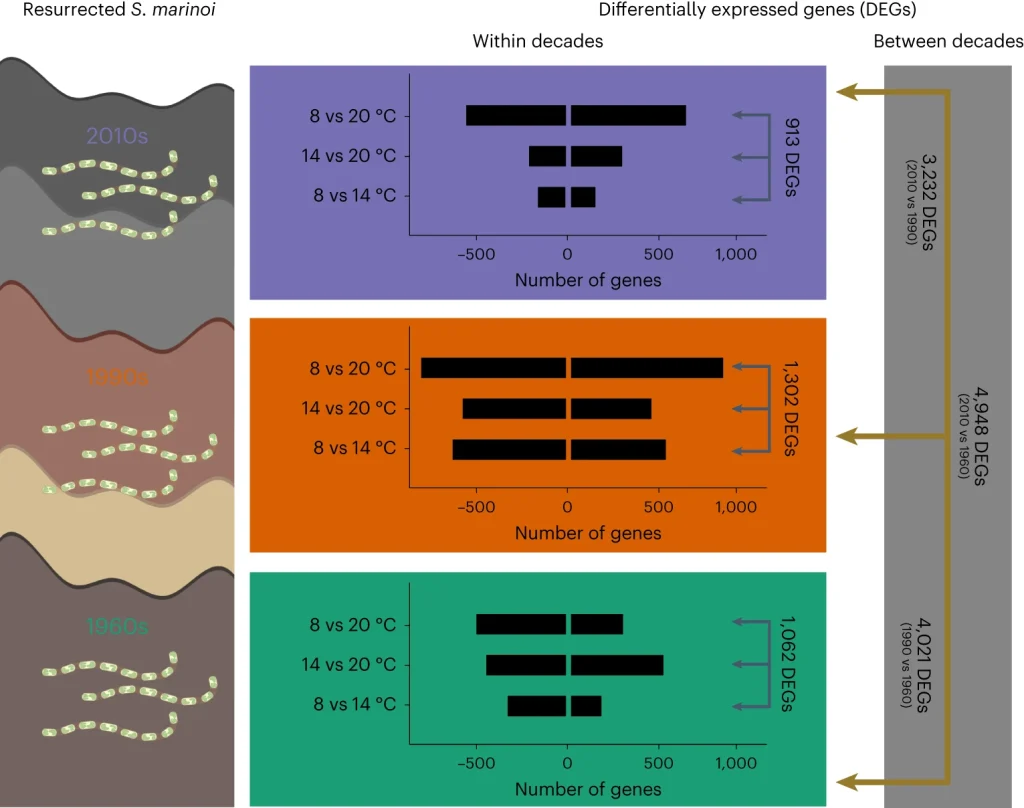Phytoplankton, super important as “producers.”
Single-celled phytoplankton account for 40% of the world’s primary production. Primary production refers to the amount of substance synthesized through photosynthesis by sunlight, which, on land, would be the plant mass produced when plants grow through photosynthesis. In the ocean, it is the amount of substance created by phytoplankton multiplying themselves through photosynthesis. Primary production is important for carbon sequestration, especially in today’s calls for reduced carbon emissions, making it a very important research topic.
Marine phytoplankton are vigorously studied due to their easy cultivation and robust growth. In the laboratory, it is possible to artificially “evolve” them by cultivating in stressed environments (high or low temperatures, changes in salinity, etc.). Research is being conducted to create new useful phytoplankton using this characteristic.
This evolution has been determined to also occur in nature.
Temperature optima of a natural diatom population increases as global warming proceeds
Phytoplankton from the 1960s, 1990s, and 2010s were collected.
In the experiments, Skeletonema marinoi, a marine plankton found in various oceans, was used. Strains of this phytoplankton from the 1960s, 1990s, and 2010s were compared. These S. marinoi strains were collected from sediments along the coast of the Baltic Sea in Finland. The collection site is at a depth of 20 meters, where the environment has been anoxic or hypoxic for at least 70 years, suppressing oxidation and maintaining low activity. Therefore, the sediments in deeper areas stably preserve past deposits, including phytoplankton in a “cold sleep” state.
The sediments were sliced for dating. Subsequently, phytoplankton were isolated from the sediment layers of the 1960s, 1990s, and 2010s, respectively. The sediments were cultured under light conditions simulating day and night at low temperatures (8°C). After 2 to 4 weeks of culture, the S. marinoi strains were isolated using a fine-tipped micropipette while observing under a microscope. These were cultured, isolating phytoplankton that lived through three eras.

Modern phytoplankton have adapted to high-temperature environments.
The cultivation characteristics of phytoplankton from the three eras were compared. Surprisingly, the optimal temperature for the fastest growth rate of the S. marinoi strain from the 2010s, closer to modern times, had increased by “1°C.” The strains from the 1990s already had a higher optimal temperature than those from the 1960s, indicating that phytoplankton had been evolving since the 1990s to adapt to ocean warming.
While the optimal temperature for the strains closer to modern times has increased, the “lower limit temperature” for their growth has also risen compared to the strains from the 1960s. This means that the strains from the 1990s and 2010s have become more susceptible to cold than those from the 1960s. It is believed that this evolutionary change occurred because, with the advancement of ocean warming, survival became possible even without maintaining cold resistance.

Gene expression levels differ in the strains from the 2010s.
Further investigation revealed that the S. marinoi from the 2010s reacted more sensitively to temperature than strains from other eras. Specifically, at higher temperatures, the cells became thicker and increased in volume. Generally, phytoplankton are said to decrease in individual cell size as sea water temperature rises and their activity decreases, but the S. marinoi from the 2010s showed the opposite response.
These differences were influenced by variations at the level of gene expression. The strains from the 2010s had enhanced gene expression for nutrient acquisition compared to other eras, allowing them to acquire nutrients without a drop in activity due to temperature rise, leading to an increase in cell volume. There were significant changes in gene expression levels over the decades, indicating that various genetic mutations occurred over 60 years.
Estimating the rate of evolution in nature.
While “forced evolution” is possible at the laboratory level, the extent of evolution in nature was previously unknown. This research has proven that it does occur in nature. In this case, it was found that “7,000 cell divisions” were needed for the optimal temperature of S. marinoi to rise by 1°C.
As the Earth’s environment changes due to warming and pollution, the day may come when the evolution of phytoplankton can be somewhat



コメント